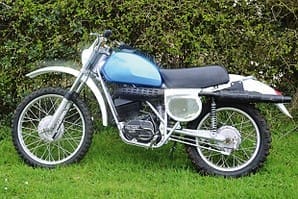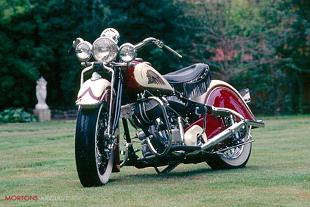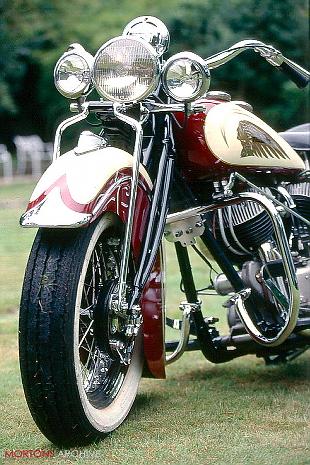
We Americans have always seemed to believe that being big is associated with being good. Nowhere has this been more true than with our motorcycles, which over a 50 year period evolved into monstrosities that made foreigners gasp in awe.
One of the largest motorcycles we ever produced was the mighty Indian Chief—an 80 inch (1310cc) beast that had its birth way back in the 1920s when Indian was starting its long downhill run after an early beginning that was bathed in glory and brilliant engineering.
Enjoy more Classic MotorCycle reading in the monthly magazine.
Click here to subscribe & save.
The mighty Chief came to the end of its road in 1953 – a bloated and obsolete monstrosity that was horribly archaic for the time. In between the early years and 1953 there existed an era when the Chief was as good as anything being produced in America and better than most—even if it was almost always an antiquated design compared to the advanced designs emanating from Europe.

The engine, was a 42-degree vee-twin with a bore and stroke of 3¼ x 4-7/16 inches. The huge alloy crankcases contained a massive crankshaft that used a forked connecting rod arrangement running on a roller bearing crankpin. The dimensions were all very large and the engine turned over slowly, so it is not surprising that very high mileages could be recorded before the lower end needed to be serviced.
Cast-iron cylinders
The cast-iron cylinders contained the side-valves, valve-springs, and ports, with the valves being set side by side. The carburation was provided by either a Linkert or Schebler 1-1/16 inch carburettor of the "butterfly" valve design, which was changed to a simpler Amal carb in 1950 when the larger 80 inch engine made its debut.
The alloy pistons had a flat top and a low compression ratio of 6.75 to 1. Any higher compression ratio masked off the flow of gas through the valves, thus causing a decrease in the power output. The large full-skirt pistons used three compression rings and one oil ring, and because they were not stressed very highly the "Black Hawk" engine would run up to 25,000 miles before any appreciable wear could be detected in the bores. Alloy heads were used, which had deep fins to help cool the engine.
 The Chief always had a dry sump lubrication system with the 2½ quart oil tank contained within the fuel tank on top of the bike, while a large oil pump was externally mounted on the right side of the engine and pushed oil to the lower end. The valve gear was lubricated only by the oil mist from the crankcase.
The Chief always had a dry sump lubrication system with the 2½ quart oil tank contained within the fuel tank on top of the bike, while a large oil pump was externally mounted on the right side of the engine and pushed oil to the lower end. The valve gear was lubricated only by the oil mist from the crankcase.
The ignition system was a 6 volt coil and distributor type, with the spark retarding to start the bike being handled by rolling back the left twist-grip. At slow speeds a skilled rider would also roll back the ignition advance, thus making, it possible for the big Chief to chug along through traffic very smoothly.
The transmission system consisted of a helical gear primary drive and a roller chain final drive. The three speed gearbox was mounted behind the engine and had wide ratios of 4.05, 5.7, and 10.1 to 1. The more powerful 80 inch Chief had higher ratios of 3.65, 5.13, and 9.02 to 1, with all models having a hand shift lever on the right side of the tank and a foot operated clutch on the left "floorboard".
British hardware
The frame into which all this brutish hardware was dropped was a twin-tube cradle type that had large tubes which look strong enough to support a small bridge. The rear suspension was the old plunger type with about two inches of travel. This doesn't seem like much travel today, but remember that in 1940 very few of the world's motorcycles had any form of rear suspension. Indian's competitor, Harley-Davidson, did not introduce a "springer" until 1952, so Indian was really quite progressive in this respect. The limited travel did provide a much more comfortable ride, however, which helped give the Chief its "Cadillac" reputation in America.
 The front suspension was taken care of by a cleanly designed girder fork with no provision for any hydraulic damping. The travel was limited to about three inches, and the lack of damping in this fork design produced a bobbing up-and-down action over a series of bumps that would be decidedly objectionable today.
The front suspension was taken care of by a cleanly designed girder fork with no provision for any hydraulic damping. The travel was limited to about three inches, and the lack of damping in this fork design produced a bobbing up-and-down action over a series of bumps that would be decidedly objectionable today.
Indian did provide one other concession to rider comfort, however, and that was the spring loaded seat. A large and well padded "buddy" seat was used mounted on a pair of coil springs. This, plus the suspension system, long wheelbase of 61 inches, and a set of fat tyres made the Chief more comfortable to ride than most of its competitors.
The tyres were huge 5.00 x 16 inch on chrome rims, while the brakes had 40.8 square inches of lining surface. The drums were cast-iron with fins for cooling, but they really were not adequate for hauling up a motorbike with a dry weight of 570 pounds.
The appearance of the Chief was typical for its era and downright staggering today. The huge size overwhelms the motorcyclist of today who has been raised on a diet of "puny" lightweights from Europe or Japan. The large and exceptionally deeply valanced fenders catch the eye first, followed by the huge tyres and monster engine. Everything is massive and strong looking. It was very definitely a "mans" motorcycle.
Eye-catching
The Indian had some other eye-catching parts, such as the wire type rear bumper, the optional raised tail pipe on the exhaust system, a chromed headlight that seems too small for the size of the bike, and a big chrome crash bar that is typically American. There is also a chrome rear carrier and chrome air cleaner cover.
Despite its beastly size, the side-valve 74 inch engine was not overly endowed with power. The stock 74 churned out about 40bhp at 4700 rpm, which provided a top speed of around 90 mph. A good 250 would beat that today, which proves just how far motorcycle design has come since the early post-war days.
 The 80 inch Chief was a little more powerful, and using a larger 1 1/8 inch carburettor they would hit 95 on about 44bhp. The company also produced their famous "Bonneville" engine, which was optionally available and had hotter cams, an even larger 11 inch Linkert carburettor, and polished and ground ports. We could not find out just how much power this engine produced, but an estimate of 48 to 50 would not seem unreasonable at about 5000 rpm. This would have provided a top speed of a little over 100 mph, which many an Indian was supposed to have done in the "good old days".
The 80 inch Chief was a little more powerful, and using a larger 1 1/8 inch carburettor they would hit 95 on about 44bhp. The company also produced their famous "Bonneville" engine, which was optionally available and had hotter cams, an even larger 11 inch Linkert carburettor, and polished and ground ports. We could not find out just how much power this engine produced, but an estimate of 48 to 50 would not seem unreasonable at about 5000 rpm. This would have provided a top speed of a little over 100 mph, which many an Indian was supposed to have done in the "good old days".
One reliable indication of the performance we do have is a test conducted by one of our American magazines, which obtained a standing start quarter mile in 15.8 seconds with a terminal speed of 84 mph. This was achieved with a Bonneville 80 and is really quite respectable considering the handicap of a 9 to 1 first gear and a three speed gearbox.
The big advantage of these older slow-revving side-valve engines was not the flat-out performance, but rather their flexibility 9f performance and their longevity. For normal riding there was little need for any more gears in the gearbox, since the broad spread of power was so substantial that the three-speed box was adequate.
There are tales of these old Indians going 50,000 miles before giving them a ring and valve job, after which another 50,000 miles could be logged before the engine needed to be completely overhauled. Try this on your Honda! I am sure that in many cases the passing of time has added some mileage to many of these legends, yet I have seen enough Indians myself to know that some really remarkable mileages could be recorded before the engine needed any attention. Not very fast but, like our farm tractors, they were very sturdy.
Lavishly finished machine
The Indian Chief was a lavishly finished machine, which is also an American philosophy. "If they don't go–chrome it", is an apt expression here, and perhaps the Chief was just being American in this respect. There was a lot of chrome, especially in the accessories that were available then, plus the bright and solid paint colours of red, yellow, green, blue, or black. The model we tested had a fairly close copy of the original Indian red but with a wee bit of metallic added to increase the "show" effect.
A ride on the big Chief is an experience not soon forgotten–at least to anyone raised on a steady diet of smaller European or Japanese bikes! Starting a Chief requires a very substantial stomping on the big kick-starter pedal, but with the use of the hand operated spark retard it is possible to find life in the engine with just a kick or two.
The sheer size of the Chief is almost overwhelming. It seems as though one is sitting on top of a two-wheeled tank. One thing that is obvious is that you must keep the bike in its vertical position. Lean it over a bit too far and it will get the better of you, and both you and the bike will end up on the floor!
 Using the foot clutch and hand shift is very awkward, and it requires a great deal of mental effort to operate these things. Shifting gears is very slow, and the gearbox has a loud "klunk" when the cogs drop into place. Shifting quickly is simply out of the question.
Using the foot clutch and hand shift is very awkward, and it requires a great deal of mental effort to operate these things. Shifting gears is very slow, and the gearbox has a loud "klunk" when the cogs drop into place. Shifting quickly is simply out of the question.
Riding around town is not easy by contemporary standards. The Indian is difficult to handle and seems clumsy and awkward, and only in a straight line does it feel at all like a motorcycle should feel. This awkwardness is somewhat compensated by the boost to one's ego, since people stare at the Chief as if you were driving a Rolls Royce down the street. People seem to notice the old warrior, and there is always a great deal of interest in the bike.
Once out on the open road the huge Indian comes into its own. In a straight line the Chief feels as stable as a tank, with side winds or bumps in the road having no effect upon its majestic travel. The suspension is acceptable on the highway, even by modern standards, but slower speeds over a bumpy side road revealed a notable lack of suspension compared to modern bikes.
With all those cubic inches flying up and down it is not surprising that there is a fair amount of vibration present—especially if the engine is wound up a bit. The Chief is not nearly as bad in this respect as its rival, the Harley-Davidson, but compared to a Norton Commando or Japanese four it does vibrate quite a bit.
The power is of the "torque" variety and definitely not the "RPM", kind. It is not necessary that a lot of revs be used to perform effectively, but we did feel that a wide-ratio four-speed gearbox would provide an improved performance. The Chief is not at all bothered by long hills or packing double, and a 60-65 mph cruising speed was well within its potential for long periods of riding. The handling at speed is much better than about 'town, but the impression is always there that chang ing direction quickly is somewhat impossible.
 One thing we did rather like about the old Indian was the way we could relax when tooling down the freeway. It reminds me of a huge American car – it isn't very pleasant in the corners, but on long straight roads you can just lean back, relax, and let the bigness of the thing just breeze down the highway. At these open road speeds a Chief will deliver about 40 mpg fuel mileage, which really isn't too bad for as much weight as it is packing.
One thing we did rather like about the old Indian was the way we could relax when tooling down the freeway. It reminds me of a huge American car – it isn't very pleasant in the corners, but on long straight roads you can just lean back, relax, and let the bigness of the thing just breeze down the highway. At these open road speeds a Chief will deliver about 40 mpg fuel mileage, which really isn't too bad for as much weight as it is packing.
In summing up the Chief we can see why it was a pretty good motorcycle in 1940, but by 1953 it was obviously an obsolete design. The British bikes were the world leaders then, and with their swinging-arm suspension, good 500 and 650cc engines, and a much lighter weight, they were making great inroads into the American market.
Due to a period of bad management dating back to before World War II, Indian found themselves bankrupt and unable to fight back. They did import Royal Enfields under the "Indian" name until 1959, but the 1953 Chief proved to be the last true Indian from the famous Springfield factory. Like the dinosaurs, the Chief became extinct and quickly faded into the past – to be studied later by those who like to probe and poke into the past with pencil and camera. Despite its obvious obsolesence, the Chief remains the last vestige of what was once a proud era in American motorcycling.
See also Indian Warrior, rise and fall. ![]()
Advert
 Enjoy more The Classic MotorCycle reading in the monthly magazine. Click here to subscribe.
Enjoy more The Classic MotorCycle reading in the monthly magazine. Click here to subscribe.



